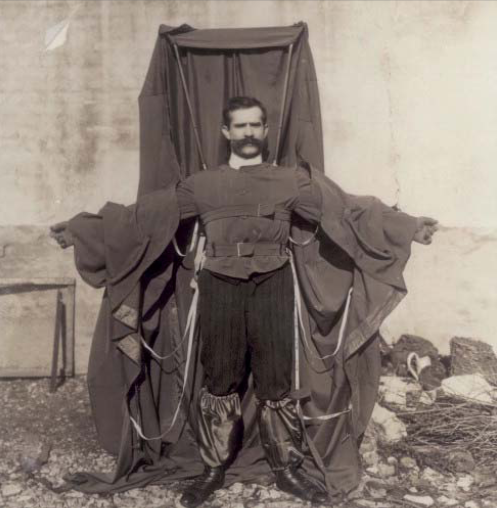Reasonability
 Franz Reichelt, sometimes known as The Flying Tailor, was a man who didn’t know when to say quit.
Franz Reichelt, sometimes known as The Flying Tailor, was a man who didn’t know when to say quit.
Quotes are from the wikipedia.
Reichelt had become fixated on developing a suit for aviators that would convert into a parachute and allow them to survive a fall should they be forced to leave their aircraft.
Living in France, in the early 1900s, it was impossible to avoid the explosion of enthusiasm flight was undergoing, and Reichelt felt he had an important contribution to make.
He presented his design to the leading aeronautic organization, La Ligue Aérienne at the Aéro-Club de France, hoping that they would test it, but they rejected his designs on the grounds that the construction of the canopy was too weak, and they attempted to dissuade him from wasting his time on further development.
Which is a nice way of saying they told him to knock it off – of course, he wouldn’t listen. What was driving the man? Fame? The Romance of the Skies?
Money?
In 1911, Colonel Lalance wrote to the Aéro-Club de France, offering a prize of 10,000 francs for a safety parachute for aviators – double the prize he had offered the year before.
Whatever the case, he got back to work:
Eager to participate, Reichelt refined his design, reducing the weight while increasing the surface area […] Further tests proved no more successful than his earlier attempts: his dummies invariably fell heavily to earth.
– and there’s the problem: despite some initial success, Reichelt had never had a successful test. He even decided to take his failures on the road.
L’Ouest-Éclair reported that in 1911 he had then made a jump himself from a height of 8 to 10 metres (26 to 33 ft) at Joinville. The attempt failed but his fall was cushioned by a pile of straw, which helped him escape injury. Le Matin reported an attempt at Nogent from a height of 8 metres (26 ft) that resulted in a broken leg.
The tailor was convinced he had the problem licked – all he needed was more height.
Reichelt announced to the press in early February 1912 that he had finally received permission and would shortly conduct an experiment from the Eiffel Tower to prove the value of his invention.
The apparent assumption behind his test was that he was going to be using a dummy.
M. Hervieu, who was present to witness the demonstration, also attempted to dissuade him from making the jump. He was concerned that the parachute needed longer to fully open than the few seconds the drop from the first platform would allow, and he also presented other technical objections to which Reichelt could not provide a satisfactory response.
The end of the experiment wasn’t pleasant. If nothing else, Reichelt stands in history as a reminder to believe your own lying eyes, and, that if something in your thinking isn’t working, it may be you.
His parachute, which had seemed to be only half-open, folded around him almost immediately and he plummeted for a few seconds before crashing into the frozen soil at the foot of the tower. […] Le Figaro noted that his eyes were wide open, dilated with terror.
To my thinking, one of the saddest aspects of his tale – if you’ll note the picture at the start of this post – was that, despite his failings as an aeronaut, he seemed to be quite a talented tailor.
[youtube=http://www.youtube.com/watch?v=BepyTSzueno]